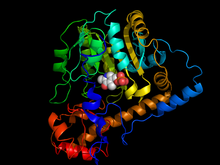User:Benzenamino/Sandbox
This is a test.
End of test.
| aspartate transaminase | |||||||||
|---|---|---|---|---|---|---|---|---|---|
 | |||||||||
| Identifiers | |||||||||
| EC no. | 2.6.1.1 | ||||||||
| CAS no. | 9000-97-9 | ||||||||
| Databases | |||||||||
| IntEnz | IntEnz view | ||||||||
| BRENDA | BRENDA entry | ||||||||
| ExPASy | NiceZyme view | ||||||||
| KEGG | KEGG entry | ||||||||
| MetaCyc | metabolic pathway | ||||||||
| PRIAM | profile | ||||||||
| PDB structures | RCSB PDB PDBe PDBsum | ||||||||
| Gene Ontology | AmiGO / QuickGO | ||||||||
| |||||||||
Aspartate transaminase (AST), also called serum glutamic oxaloacetic transaminase (SGOT) or aspartate aminotransferase (ASAT/AAT/AspAT), is a transaminase enzyme (EC 2.6.1.1). It is similar to alanine transaminase (ALT) in that both enzymes are associated with liver parenchymal cells. The difference is that ALT is found predominantly in the liver, with clinically negligible quantities found in the kidneys, heart, and skeletal muscle, while AST is found in the liver, heart, skeletal muscle, kidneys, brain and red blood cells.[2] As a result, ALT is a more specific indicator of liver inflammation than AST, as AST may also be elevated in diseases affecting other organs, such as myocardial infarction, acute pancreatitis, acute hemolytic anemia, severe burns, acute renal disease, musculoskeletal diseases, and trauma.[3]
- ^ PDB: 1AAMAlmo SC, Smith DL, Danishefsky AT, Ringe D (March 1994). "The structural basis for the altered substrate specificity of the R292D active site mutant of aspartate aminotransferase from E. coli". Protein Eng. 7 (3): 405–12. doi:10.1093/protein/7.3.405. PMID 7909946.
{{cite journal}}: CS1 maint: date and year (link) CS1 maint: multiple names: authors list (link) - ^ http://dynaweb.ebscohost.com/Detail?sid=923b5a81-7daf-46b7-bdb2-86d8649da6ef@sessionmgr13&vid=&db=dme&ss=AN+%22316452%22&sl=ll
- ^ http://www.rnceus.com/lf/lfast.html

